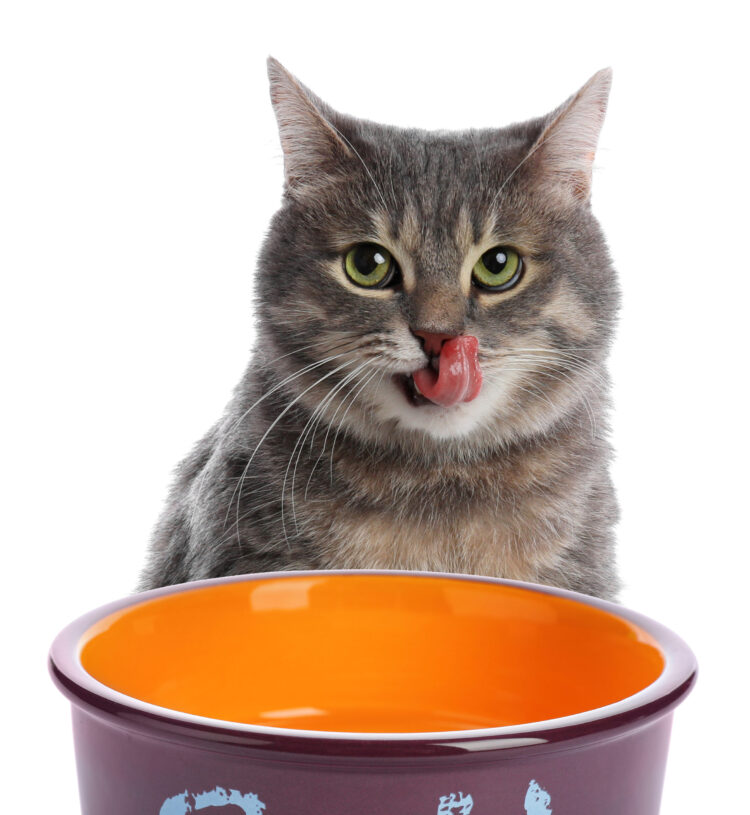
This is a sponsored post*
When it comes to feeding your cats, the less processed their food is, the better it is for their health. A raw diet is the least processed of all feline diets, and raw feeding is becoming more and more mainstream as cat parents look for alternatives to highly processed pet foods. I’ve been feeding raw for more than ten years, and have seen my cats thrive on it.
Deciding to feed raw was not an easy decision for me. In this post, I’m sharing my process of how I came to the decision to make the switch, how I researched the various raw diets and how I transitioned my cats. I hope this information will help those of you who may have thought about feeding raw, but aren’t entirely comfortable with the idea, or those of you who want to make the change but feel overwhelmed by how to do it.
A tale of five cats
My first cat Feebee was on a dry diet for most of his life, because that’s what veterinarians recommended in the 1980’s. He was a healthy, happy cat – until he wasn’t. When he was 10 years old, he developed bladder stones. After surgery, his vet put him on a canned “prescription” diet with what I now know are inappropriate ingredients for an obligate carnivore. Four years later, he developed inflammatory bowel disease, which transitioned into intestinal lymphoma. After seven months of chemotherapy, which he tolerated fairly well, I had to let him go.
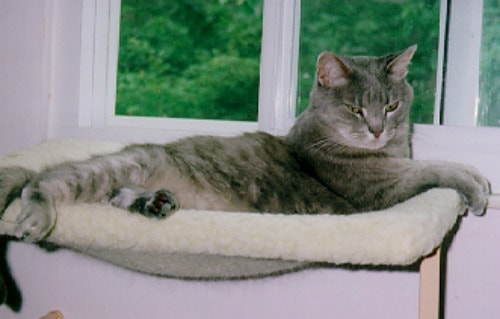
When I adopted Amber from the animal hospital I managed, she was eating a mix of dry and canned food – the same diet we fed the cats who boarded at the hospital. She was two years old and overweight. In the late 1990’s, some veterinarians, including the one I worked with, began to understand that cats need moisture, and that a high protein low carb diet could help cats lose weight. From then on, Amber ate a premium grain-free canned food. She became hyperthyroid when she was seven years old. She did well after going through the I131 treatment, until an acute illness took her from me when she was 12 years old.
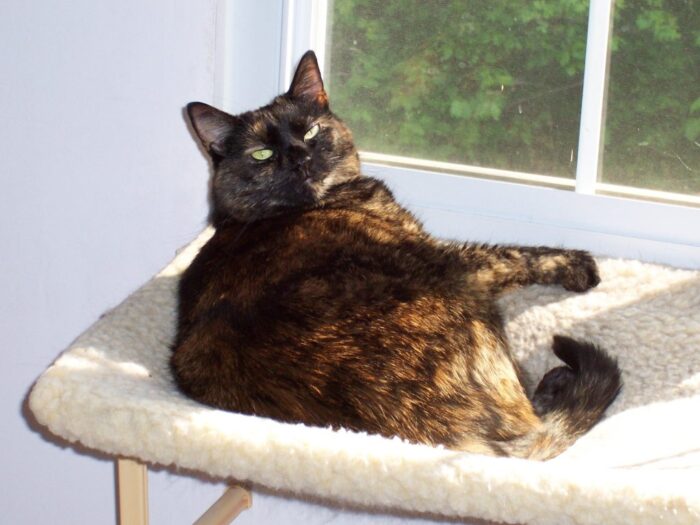
I don’t know how old Buckley was when I adopted her. Most likely, she was already a senior in her teens. I fed her the same grain-free canned diet Amber ate. She developed restrictive cardiomyopathy three years after I brought her home, and declined rapidly.
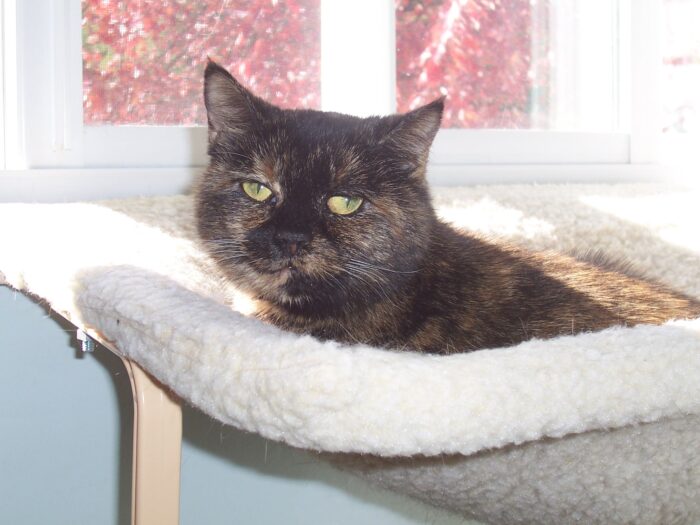
Allegra was about seven months old when I adopted her. She was fed a “prescription” intestinal diet at the animal hospital where she lived after being rescued because she had diarrhea. I switched her to the same grain-free canned diet Amber was eating, and within days, her stools were normal. I started introducing raw to her diet about a year after I adopted her.
Ruby was about nine months old when she joined our family. She was fed a dry kitten diet from a major manufacturer in her foster home. She didn’t get any wet food. Her coat was scruffy and rough looking. I immediately put her on the raw diet Allegra was eating at the time. The transformation was almost shocking. Within a week, her scruffy, dull coat turned soft and shiny!
Exploring raw feeding
I had been interested in feeding raw for a long time before I finally made the switch. Some of my friends fed their cats raw even back in the 1980’s. It made complete sense to me, but my comfort level had to catch up with my knowledge level. The veterinarians I worked with all cautioned against raw feeding. While that is beginning to change with more holistically oriented and open-minded vets understanding the importance of species-appropriate nutrition, the change has been slow.
I turned to the internet, and while there was a lot of information available online, some of it fantastic, a lot of it was just plain wrong.
Then I met Dr. Andrea Tasi of Just Cats, Naturally. She became our vet, and having a vet who was comfortable with and recommended raw food changed everything for me. Dr. Tasi shares how she came to embrace raw food in Feeding Raw: A Veterinarian’s View.
Dr. Tasi’s guidance. along with websites like Dr. Lisa Pierson’s catinfo.org and the Feline Nutrition Foundation website, which is now hosted by Hare Today, a quality raw meat supplier, finally helped me make the switch.
Choosing a raw diet
You have three choices when it comes to feeding raw: make your own food, feed a commercial frozen raw diet, or feed a commercial freeze-dried raw diet (freeze dried diets need to be rehydrated before feeding.) Making my own food was out. I’m vegetarian, and the idea of handling that much raw meat was just not appealing to me. Also, I barely cooked for myself at the time. None of my cats ever took to the freeze-dried diets, so I landed on frozen raw diets. I keep a list of the brands I recommend here.
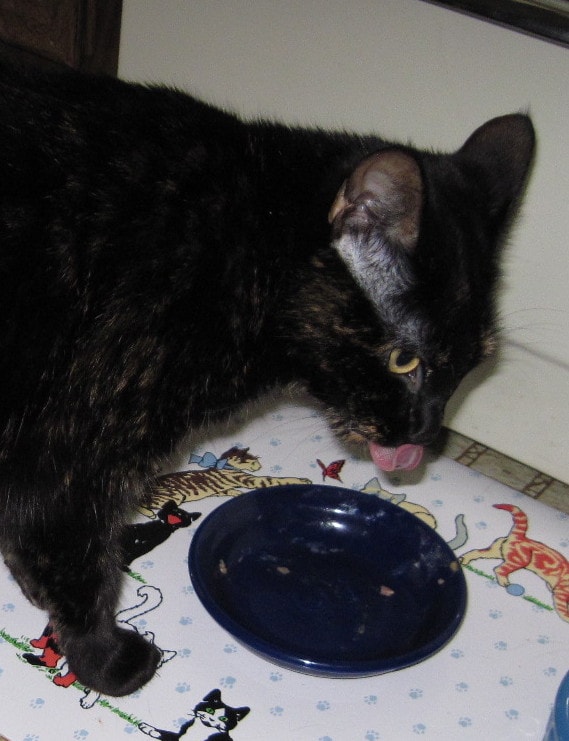
Darwin’s for the win
Of all the frozen raw diets I’ve fed over the years, Darwin’s continues to emerge as the clear favorite. Allegra loves it, and I love both what’s in it and what’s not.
- 100% meat – no animal-by-products or fillers
- Ethically sourced human grade ingredients from farms they trust
- Formulated under the guidance of veterinary nutritionists
- Free range, pasture raised, cage-free meats
- No GMO
- No steroids
- No hormones
- Made fresh: you will receive your meals 4-6 weeks from production
- Ready to serve
The food comes packaged in convenient 8 ounce sealed packs. It takes about 24 hours for one pack to thaw in the refrigerator, so feeding raw is no harder than feeding canned food. The only difference is that instead of opening a can, you’re defrosting a pack of food.
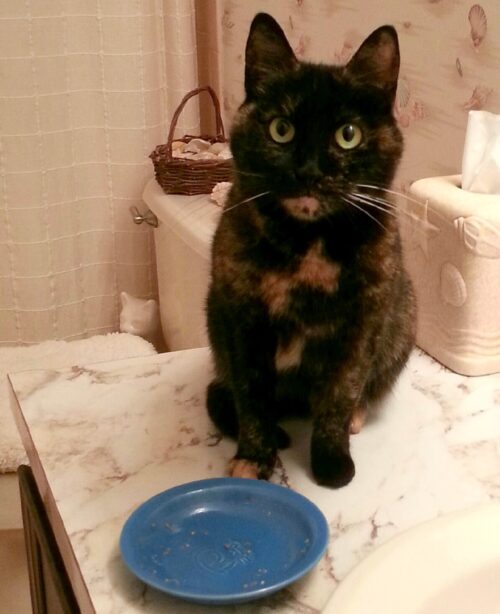
Transitioning my cats to raw
Transitioning was easier than I expected. Of course, every cat is different, but with my cats, it really ended up being a case of “finally! She figured out what I’m really supposed to eat!” Allegra and Ruby took to raw food right away. If your cats aren’t as readily accepting, there’s a wealth of resources from the Feline Nutrition Education Society on how to switch cats to a raw diet here.
Would feeding raw have prevented some of the health issues that Feebee, Amber, and Buckley dealt with? Maybe, maybe not. Ruby was raw fed and still died from kidney cancer. Allegra is hyperthyroid. Nutrition can only do so much, but it’s the only thing we have any control over. We can’t change our cats’ genes, but we can change what we feed them.
I hope sharing my journey to raw will help some of you who are on the fence to give it a try. Your cats will thank you for it.
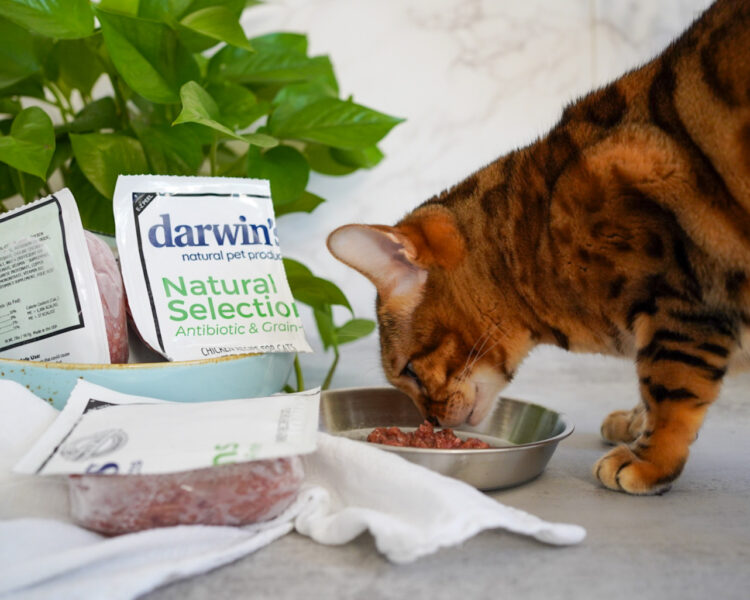
Special offer: get 10 pounds for $14.95
Darwin’s has an introductory offer that can’t be beat so you can try this for your own cats: For $14.95, you get 10 pounds of raw food. You can customize the proteins depending on your cat’s taste preferences.
Use code PURRSOFWISDOM to take advantage of this special offer.
For more information and to order, please visit DarwinsPet.com.
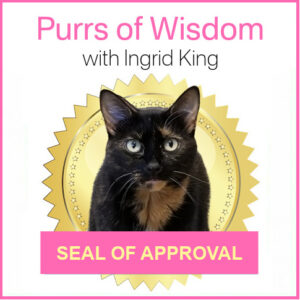
*This post is sponsored by Darwin’s Natural Pet Products. Purrs of Wisdom is an affiliate partner of Darwin’s Natural Pet Products. This means that if you decide to purchase through any of our links, we get a small commission. We only spread the word about products and services we’ve either used or would use ourselves.
Photo at top of post Depositphotos, photo with Darwin’s via Darwin’s Facebook page, used with permission

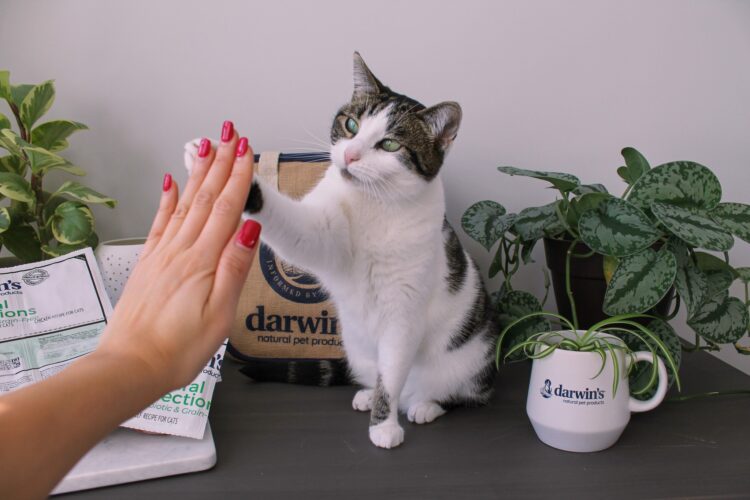
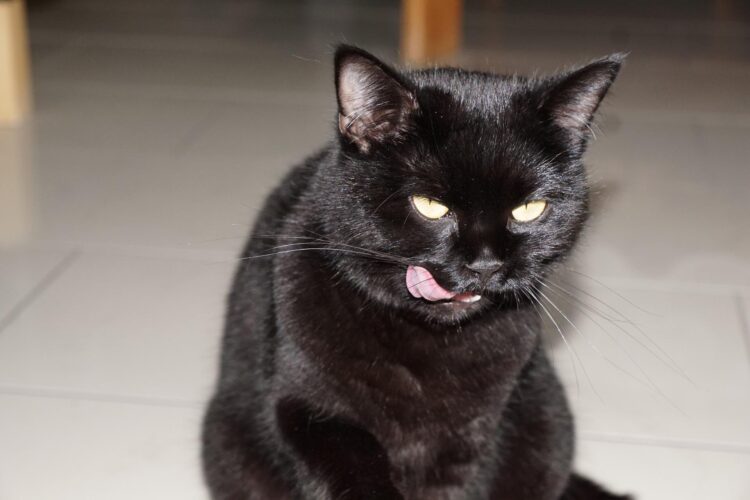
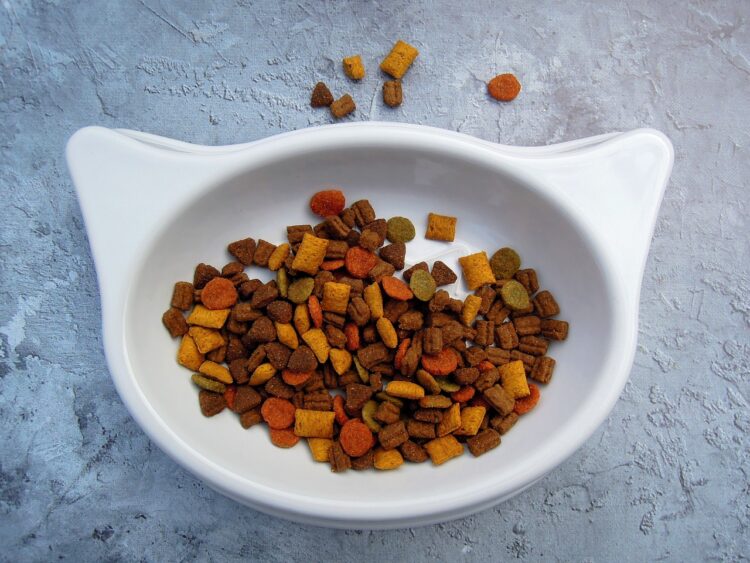
My cat liked Darwin chicken raw. I grinded my own chicken raw which she would not eat. She does not like Marty’s raw dehydrated. Finding what she will eat is interesting. I also noticed her fur is beautiful now and she seems to be satisfied with eating less. Her weight seems perfect now.
I’ve had an epiphany since I started feeding my cat a raw diet. I made the decision to switch to raw cat food because I wanted to give my cat a diet that is more in accordance with her evolutionary needs. Her health and vibrancy are changing as I work through the complexities of portioning, finding premium raw products, and making sure her diet is balanced. Her coat has more sheen, and her joyful antics exude a certain energy. Knowing that I’m providing my cat with a diet that aligns with her evolutionary needs gives me a sense of fulfillment, even though the process requires diligence and education. It’s an investment in their health and an intriguing journey into the realm of raw feeding that will strengthen our relationship as we travel this road together.
Having owned a large veterinary practice, I am acutely aware of the promotion of manufactured pet foods; especially the “covenient dry foods”, together with the associated problems.
My family had always fed raw meat plus cooked chicken or rabbit for variation and this practice continued in our veterinary practice.
Now, my four Siamese and Oriental cats look forward to their raw stir fry beef strips (supermarket meat that doesn’t have to be handled other than served from its tray) plus air-fried drumsticks as the evening staple, with supermarket tuna chunks plus 1/8 cup of Purina biscuits for breakfast. The biscuits are for teeth, as are a raw chicken neck each twice a week.
Thank you for sharing your experience, Marilyn. For my US readers, “biscuits” is the British term for dry food.
I remember when Darwin came . The local independent store carried it until they had some problems. I have only seen dog treats by them in the recent yrs. I don’t think I tried their raw, I think it was their grain free. I know several vets and the vet school are not fans of raw. In fact, when my youngest had to go to ER she was put in isolation because she had a few freeze dried food recently. I am not a fan of the prescription diets, so much junk in them.
You really did do some great research when you decided to change to a raw diet. I trust all of your recommendations before I would anyone else’s.
Thank you, Janine, that means a lot to me.